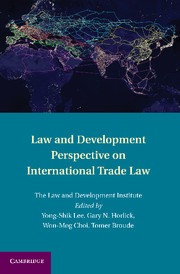Book contents
- Frontmatter
- Contents
- About the Editors and Authors
- Acknowledgments
- Law and development perspective on international trade law
- Introduction
- Part I Developing Countries and International Trade
- Part II Law and Development in the World Trade Organization
- Part III Law and Development in Free Trade Agreements
- Part IV Law and Development in Regional Initiatives
- 13 Islands of Prosperity and Poverty
- 14 Trade Preferences and Economic Growth
- 15 Economic Development of North Korea
- 16 Applying the “Specificity” Test in Countervailing Duty Cases in the Context of China's Foreign Investment Policies
- 17 Nonconclusions
- Epilogue
- Index
- References
15 - Economic Development of North Korea
Call for International Trade-Based Development Policy and Legal Reform
from Part IV - Law and Development in Regional Initiatives
Published online by Cambridge University Press: 05 August 2011
- Frontmatter
- Contents
- About the Editors and Authors
- Acknowledgments
- Law and development perspective on international trade law
- Introduction
- Part I Developing Countries and International Trade
- Part II Law and Development in the World Trade Organization
- Part III Law and Development in Free Trade Agreements
- Part IV Law and Development in Regional Initiatives
- 13 Islands of Prosperity and Poverty
- 14 Trade Preferences and Economic Growth
- 15 Economic Development of North Korea
- 16 Applying the “Specificity” Test in Countervailing Duty Cases in the Context of China's Foreign Investment Policies
- 17 Nonconclusions
- Epilogue
- Index
- References
Summary
Introduction
The image of the Democratic People's Republic of Korea (hereinafter “North Korea”) is that of a hermit closed to the outside world and doing unsavory things, such as developing nuclear arsenals and long-range missiles behind the iron curtain. With this image in mind, one may easily jump to the conclusion that this hermit country would never make a genuine attempt to be part of the international economic and trading system. However, North Korea, for its part, has shown consistent effort to become integrated to the world economy by soliciting international investment and attempting participation in international trade. According to a recent Newsweek article, despite various sanctions imposed on North Korea by the international community to deter its nuclear ambitions, Pyongyang today has diplomatic and commercial relations with more than 150 countries, including most European Union member states. Furthermore, with assistance from its closest ally, China, North Korea has adopted many economic measures to improve its lagging infrastructures, including major mining facilities. The recent global financial crisis appears not to have affected the North Korean economy as much as it has the rest of the world.
- Type
- Chapter
- Information
- Law and Development Perspective on International Trade Law , pp. 356 - 375Publisher: Cambridge University PressPrint publication year: 2011
References
- 1
- Cited by



